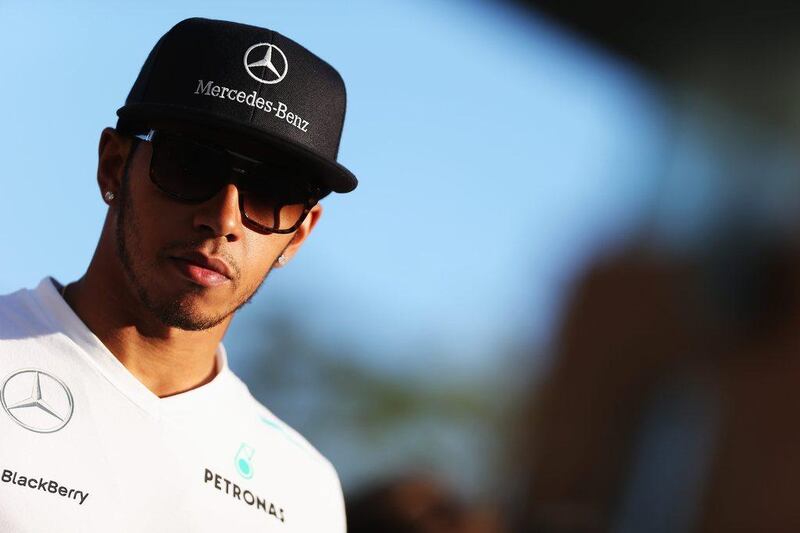Made for the media, transformed by the media and a victim of the media, Lewis Hamilton is one of those athletes who come along only every so often; apparently hand-picked at birth to rise to global relevance.
Bound for the top, such sportsmen have a certain something that makes their ascendancy predestined.
Tennis has the Williams sisters and their overcoming of gang warfare on the streets of California to dominate the female game.
Football has Lionel Messi, who required expensive hormone treatment before he could go on to become the best player in the world.
Golf? Tiger Woods and the racial barriers. Boxing? Floyd Mayweather Jr being used as a human shield by his bullet-dodging father.
Hamilton’s tale is soaked neither in danger nor distress, but his route to the top is, like that of his aforementioned peers, characterised by indefatigable drive and intense determination.
It also includes the story of how a 10-year-old boy prophesied his future to a multimillionaire McLaren chief only to see it come true.
Hamilton’s story is a writer’s dream and the media undoubtedly helped as he very publicly evolved from karting prodigy to global celebrity.
It is telling that, despite the Englishman having not won the Formula One world championship since 2008, he remains the closest thing the sport has to a worldwide superstar.
Sebastian Vettel may be the indomitable driver having staked a claim on a fourth consecutive world title, this year, but in terms of racing personality Hamilton remains arguably the most engrossing (for good and bad), most exciting (on and off track) and most popular (to sponsors and spectators).
That is helped, naturally, by his willingness. While Vettel shuns social media, Hamilton embraces it.
Since last season, he has become prolific on both Twitter and Instagram, providing fans an insight into his life that goes beyond selfies, sunsets and celebrities.
With added exposure comes occasional mistakes and his posting of team telemetry last year earned him much scorn. Yet that is Hamilton.
As his original Twitter handle aptly put it, @IamLewis4Real. Online, at least, there is no artifice.
The same cannot be said of Hamilton when he is sat in front of a camera. He is renowned in the F1 paddock for his bland, on-message answers during press conferences.
Always mannerly, but rarely memorable; always comprehensible but almost never controversial.
The exceptions usually come immediately after a race when the adrenalin is still flowing and his lips are loose.
A 2011 quip claiming he was punished by race stewards “maybe because I’m black” was ill-judged and irresponsible, but it was also a perfect example of his naivety.
He is the boy who never grew up and at such times it is easy to forget he is 28 years old, not 18.
Adrian Sutil, the Force India driver who raced alongside a young Hamilton in junior formulae, believes the fact his former teammate signed for McLaren at age 13 stunted his character development as he lived out his childhood in a spotlit bubble.
“There is a time when people have to grow up and he hasn’t done it,” Sutil said.
“It is not easy for a young driver when you are very talented and then you break through into F1. You suddenly go from being not interesting to being at the top and everyone loves you.
“You get the best from everywhere, you have a lot of money suddenly and this all affects your life. You don’t have any real friends anymore; you don’t know what that means.”
The Williams sisters and Tiger Woods both benefited from strong-willed, supportive fathers and in that regard Hamilton is no different. In truth, however, courtesy of Anthony Hamilton — who had taken redundancy from his job with British Rail to focus on his son’s career — Lewis was working in a bubble even before he had signed for McLaren.
In 1997, while Lewis raced karts in Kent, his father told motorsport writer Simon Arron he had spent £30,000 (Dh177,000) on his son’s racing career the previous season.
He had even bought a beat-up Bedford bus that the family would use as a makeshift motorhome.
“It enabled him to stay with the guys and learn more about the machinery and how to maintain it, before then ambling off to bed in a cosseted environment,” Arron wrote.
The early investment paid off: the next time Arron met Anthony was in the paddock at the 2007 Australian Grand Prix, where Lewis was making his F1 debut.
The prodigy finished third in Melbourne and would go on to miss out on the world championship title by a single point. “F1’s new star — and it’s not the champ” read the BBC headline the day after the season finale.
Back then, Hamilton was still a figure of intrigue, talented no doubt, but young and raw. Nowadays, he continues to evoke intrigue, but no longer while on track.
Nobody has any doubt as to his abilities behind the wheel.
Watching Lewis Hamilton driving a Formula One car in qualifying is like watching the last scene of a movie when you know everything is going to work out fine: The good guy is going to get the girl, the bad guy is going to get his punishment and Hamilton is going to nail his lap to the best of his considerable talents. It is as certain as the closing credits.
The intrigue instead comes from Hamilton’s private life: his on-off relationship with the US pop star Nicole Scherzinger and his decision to split from father Anthony’s management company in favour of Simon Fuller, the man behind the careers of David Beckham and Andy Murray.
His circle of friends appear to include a growing array of US rappers and his lexicon has expanded to include several Americanisms, most gratingly, to the ear of his countrymen, “homie”.
He was accused by The Guardian earlier this year of sounding “as if he is being written by a parodist” after he requested a paddock pass for his pet bulldog and had his new £20m private jet painted blood red.
Yet he maintains he is simply living his life and cares not what people think.
His move to Mercedes at the start of the year was his emancipation — he is considering releasing his own music next year — and while he is at ease dealing with the attention that follows him, he insists he prefers anonymity, describing himself as an incredibly lucky twenty-something stuck in the spotlight.
“When I was a kid, I didn’t think too much about the fame,” he said. “I just wanted to be the best racing driver in the world and race in Formula One.
“I definitely had no comprehension of all that would come with it: People noticing you, signing autographs, being on TV.
“It’s something I hadn’t even thought about and that’s why I like going to the States because when I go there, nobody notices me. I can go anywhere and I can just blend in with everyone.
“That is a great feeling, to just be in the norm and do normal things without cameras chasing you or people making comments about what you’re doing.”
So long as Hamilton continues racing, the cameras and comments will persist. The story of the boy who went from Stevenage to superstardom is too compelling to ignore.





